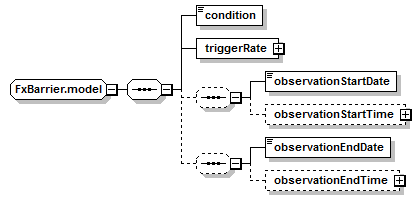
Namespace: |
|
Content: |
6 elements |
Defined: |
globally in fpml-fx-complex-5-8.xsd; see XML source |
Includes: |
definitions of 6 elements |
Used: |
at 2 locations |

Complex Content Model |
|
<xsd:sequence>
<xsd:element name="condition" type="ConditionEnum"/>
<xsd:sequence minOccurs="0">
</xsd:sequence>
<xsd:sequence minOccurs="0">
</xsd:sequence>
</xsd:sequence>
</xsd:group>
|
Type: |
ConditionEnum, simple content |
|
enumeration of xsd:token
|
Enumeration: |
|
||||||||||||
minLength: |
0
|
Type: |
xsd:date, predefined, simple content |
Type: |
BusinessCenterTime, complex content |
Type: |
xsd:date, predefined, simple content |
Type: |
BusinessCenterTime, complex content |
Type: |
Schedule, complex content |
|
XML schema documentation generated with DocFlex/XML 1.9.0 using DocFlex/XML XSDDoc 2.8.0 template set. All content model diagrams generated by Altova XMLSpy via DocFlex/XML XMLSpy Integration.
|